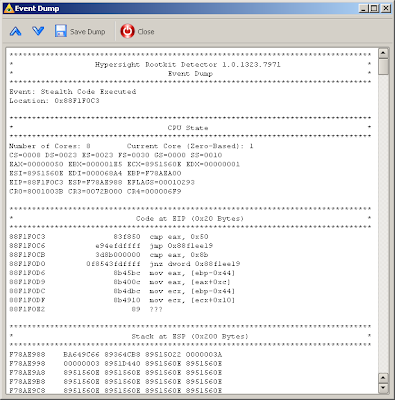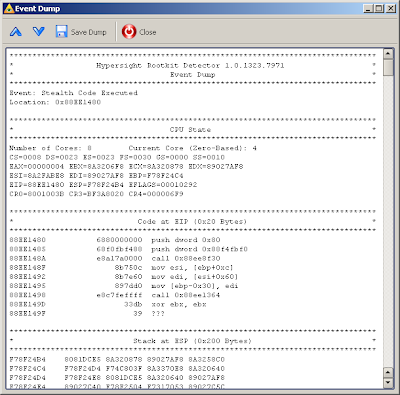HVT-based rootkits became a new headache for anti-malware vendors since their appearance in 2006. There are no working HVT rootkits yet (only PoC implementations), but who knows what happens later? It is possible (not easy though) to create a HVT rootkit with extra functions such as keylogging, HDD access, network communication or traffic interception. Plenty of helpful source codes are available for a rootkit creator (such as open source hardware drivers, open source operating systems etc). VT-based rootkits are very hard to detect when they are already installed. Moreover, no existing anti-malware product is capable of preventing a VT-based rootkit from installing.
So what is the solution? It is possible to detect HVT rootkits by monitoring indirect results of their activity. The advantages and disadvantages of this approach are well described in Joanna Rutkowska’s articles. The methods described are not generic and can be cheated by a rootkit (e.g. Blue Chicken method). Furthermore, they don't allow unambiguos detection of a rootkit since they don't give any access to the rootkit’s body.
We have found another approach. Here is its brief description.
The idea is to intercept a hypervisor's start by another hypervisor (let’s call the latter a Virtual Intrusion Prevention System, or VIPS). When any hypervisor (malicious or legitimate) starts, it turns VM root mode on. This event can be easily intercepted by a VIPS. So what's next? There are 2 ways to handle this event: blocking a hypervisor completely, or allowing it to work through emulation.
The first way consists in emulating a PC with disabled HVT feature in BIOS. This will block a HVT rootkit from working.
The second way consists in allowing a hypervisor to work through emulated hardware virtualization (or nesting). This should be done for legitimate virtualization software.
In both cases (blocking or emulating), a VIPS intercepts a hypervisor at the moment it tries to start. VIPS can read the hypervisor’s body and analyze it. A notification message can be shown.
At present only the first case is implemented - preventing a hypervisor's start. The second case is currently in development. We hope it to be ready soon.
To check the new feature of the Hypersight Rootkit Detector, we have used the
CHKSVMX tool from Invisible Things Lab. When we run CHKSVMX on a PC with installed Hypersight RD, a message from HRD appears that a hypervisor’s start has been blocked. CHKSVMX tool also reports a disabled HVT feature (see images below).

Detecting and blocking hypervisor on Intel VT-x

Detecting and blocking hypervisor on AMD-V
We didn’t test the new HRD feature with the Blue Pill because the Blue Pill is currently implemented on x64 platform only. When we create a x64 version of Hypersight, it will be detecting the Blue Pill as well. The opportunity to catch a Blue Pill does exist and we have proven it.
The approach described can be successfully implemented in anti-malware software to achieve HVT rootkits blocking. It can also be integrated with virtualization software. The real BP stopping aproach can demotivate malware creators from exploring the area of HVT rootkits (mind that the creation of a full-scale HVT rootkit is a big challenge comparable to development of a mini-OS).




















